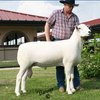Breeds Flashcards
(148 cards)
6 breeds that make up 3/4 of the sheep industry
- Delaine Merino
- Hampshire
- Rambouillet
- Romney
- Southdown
- Suffolk
What are the 7 ram breeds? Which are most popular?
- Hampshire
- Suffolk
- Shropshire
- Oxford
- Cheviot
- Montadale
- Southdown
- Hampshire
- Suffolk
What are the 5 dual-purpose breeds?
- Columbia
- Dorset
- Dorper
- Lincoln
- Romney
What are the 12 ewe breeds?
- Merino
- Rambouillet
- Tunis
- Debouillet
- Corriedale
- Targhee
- Finnsheep
- Border Leister
- Polypay
- Panama
- Katahdin
- Romanov
Characteristics of ewe breeds (7)
- Prolificacy
- Wool
- Milking
- Fertility
- Adaptability
- Medium size
- Hardiness
A nonpurebred animal resembling and having the majority of its genetics from one breed
Grade
An animal sired by a male of one breed and out of a dam of another breed
Crossbred
An animal whose sire and dam are of the same breed and their ancestors were of the same breed also
Purebred
A group of animals of common origin that have certain distinguishing characteristics and are capable of transmitting these characteristics to their offspring in a uniform manner
Breed
An ideal or standard of perfection, including all the characteristics of an animal that makes it better suited for a specific purpose or use
Type
35-40% of U.S. sheep are
Fine wool breeds
Advantages of fine wool breeds (3)
- Adaptable to hot/cold climates
- Breed throughout the year
- Great flocking instinct
Disadvantages of fine wool breeds (4)
- Slow growth
- Light muscling
- Excessive hoof growth in wet areas
- Fleece rot in wet areas
5 Hair Type breeds
Barbados Blackbelly
Dorper
White Dorper
Katahdin
St. Croix
9 Meat type breeds
- Hampshire
- Suffolk
- Southdown
- Shropshire
- Dorset
- Cheviot
- Montadale
- Oxford
- Texel
Long Wool Breeds (5)
Romney
Lincoln
Cotswold
Leicester
Finn
Advantages of long wool breeds (4)
- Large size (Lincoln - biggest; Romney - smallest)
- Fast growing lambs
- Milking ability
- Adapted to high rainfall
Disadvantages of Long wool breeds (2)
- NOT heat-tolerant
- Low quality wool
Medium Wool Breeds (8)
PPRTECCT
- Columbia
- Corriedale
- Targhee
- Panama
- Polypay
- Romanov
- Tunis
- East Friesian
Fine Wool Breeds (5)
- Rambouillet
- Merino
- Cormo
- Debouillet
- Booroola Merino
Merinos originated in _____.
Spain
Facts about Merino (4)
- Size
- Wool grade
- Shrinkage
- Prolificacy
- Fairly upstanding (but less than Rambouillet); Small frame size
- Fine wool grade
- 45-65% shrinkage
- Prolificacy: 115-120%
Disadvantages of Merinos (3)
- Slow growth
- Small
- Poor carcass traits

Merino
Wrinkles on chest
































